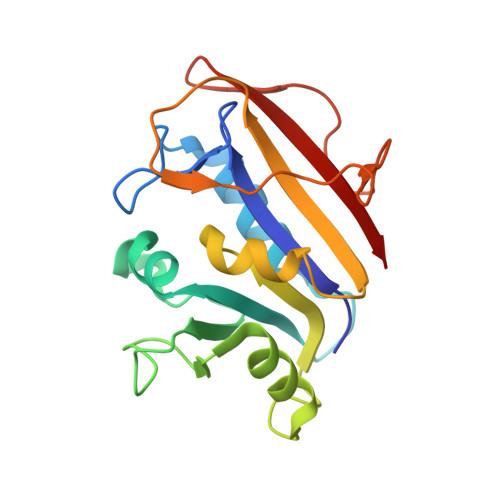Analysis of two polymorphic forms of a pyrido[2,3-d]pyrimidine N9-C10 reversed-bridge antifolate binary complex with human dihydrofolate reductase.
Cody, V., Galitsky, N., Luft, J.R., Pangborn, W., Gangjee, A.(2003) Acta Crystallogr D Biol Crystallogr 59: 654-661
- PubMed: 12657784
- DOI: https://doi.org/10.1107/s0907444903001951
- Primary Citation of Related Structures:
1MVS, 1MVT - PubMed Abstract:
The results of the crystal structure determination of human dihydrofolate reductase (hDHFR) as a binary complex with the potent N9-C10 reversed-bridge antifolate inhibitor 2,4-diamino-6-[N-(3',4',5'-trimethoxybenzyl)-N-methylamino]pyrido[2,3-d]pyrimidine (1) are reported for two independent polymorphic rhombohedral R3 lattices [R3(1) and R3(2)]. Data from these two crystal forms were refined to 1.90 A resolution for complex R3(1), with R = 0.186 for 9689 data, and to 1.80 A resolution for complex R3(2), with R = 0.194 for 13 305 data. Changes in the loop geometry between the two structures reflects contact differences in the packing environments in the two R3 lattices. The largest changes (between 0.5 and 1.7 A) are observed for the loop regions encompassing residues 16-25, 40-48, 81-89, 99-108, 143-148 and 161-169. Comparison of the intermolecular contacts of these loops reveals that the R3(2) lattice is more tightly packed, as reflected in its smaller V(M) value and smaller solvent content. The conformation of inhibitor (1) is similar in both structures and the N9-C10 bridge geometry is more similar to that observed for the normal C9-N10 bridge of trimetrexate (TMQ) than to the other N9-C10 reversed-bridge antifolates previously reported. The effect of the N9-C10 reversed-bridge geometry is to distort the bridge from coplanarity with the pyrido[2,3-d]pyrimidine ring system and to twist the C10 methylene conformation towards a gauche conformation. This also influences the conformation of the methoxybenzyl ring, moving it away from a trans position and placing the 5'-methoxy group deeper within the hydrophobic pocket made by Leu60, Pro61 and Asn64 of the hDHFR active site.
Organizational Affiliation:
Hauptman-Woodward Medical Research Institute Inc., Buffalo, NY 14203, USA. cody@hwi.buffalo.edu
















